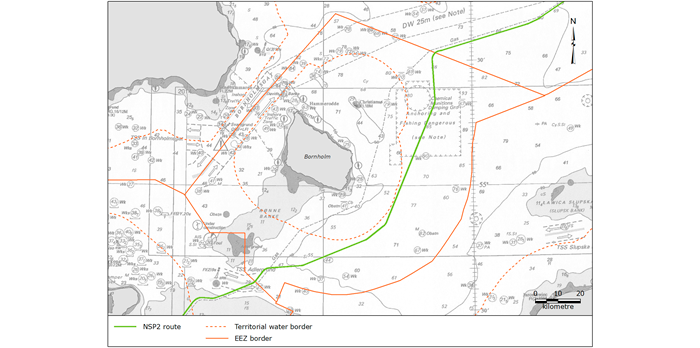Nord Stream 2 AG has been granted a permit to construct natural gas pipelines on the Danish continental shelf.
The Danish Energy Agency has granted a permit to Nord Stream 2 AG to construct a section of the Nord Stream 2 natural gas pipelines on the Danish continental shelf southeast of Bornholm in the Baltic Sea.
The permit is granted pursuant to the Continental Shelf Act and in accordance with Denmark's obligations under the UN Convention on the Law of the Sea. Denmark is obliged to allow the construction of transit pipelines with respect to resources and the environment and if necessary to assign the route where such pipelines should be laid.
The route covered by the permit is shown on the figure.
Several applications
Since 2017, Nord Stream 2 AG has forwarded three applications to the Danish Energy Agency with three different routes. On April 3, 2017, the Danish Energy Agency received an application for a permit to construct transit pipelines southeast of Bornholm in Danish territorial waters and on the Danish continental shelf. The company withdrew this application in June 2019.
On August 10, 2018, the Danish Energy Agency received an application for a route northwest of Bornholm on the continental shelf. As this route raised a number of questions in relation to the impact on the environment and shipping, the DEA requested Nord Stream 2 AG in March 2019 to investigate a southeastern route on the continental shelf.
Read more about the three applications.
On April 15, 2019, Nord Stream 2 AG applied for two route alternatives on the continental shelf southeast of Bornholm with a length of respectively 147 km and 164 km.
The Danish Energy Agency has assessed that the southeastern route on the continental shelf is preferable to the northwestern route. This is mainly due to an assessment of the impact on shipping and Natura 2000 areas. Among the two southeastern route alternatives proposed by the company, the Danish Energy Agency has approved the shortest route, since this route provides the least risk and impact from an environmental and safety perspective and therefore is the preferable choice.
Public consultation and consultation with neighbouring countries
Nord Stream 2's Environmental Impact Assessment (EIA) for the southeastern route on the continental shelf has been in public consultation, and all responses received have been processed by the Danish Energy Agency and other Danish authorities. Since the project may have a transboundary impact on the environment, the project is within the scope of the ESPOO Convention, and consultations have therefore been conducted under this framework.
Based on consultation responses and close dialogue with relevant Danish authorities, the Danish Energy Agency has assessed that the southeastern route which has been granted a permit to is the preferable based on environmental and safety considerations.
Please find the permit and more information about the Nord Stream 2 permit.
Background
The pipeline project on the Danish continental shelf is part of a larger pipeline project, consisting of two parallel pipelines of 1230 km for the transport of gas from Russia to Germany, cf. figure 2. The natural gas pipelines starts in Russia and passes through Finnish, Swedish, Danish and German marine areas and goes ashore at the German coast. The pipelines can transport 55 billion m3 of natural gas per year. The authorities in Russia, Finland, Sweden and Germany have granted permits for the project.
Contact:
Chief Advisor Katja Scharmann, tel. +45 33 92 66 72, e-mail: ksc@ens.dk
Head of Media Relations Ture Falbe-Hansen, mobile: +45 25 13 78 46, e-mail: tfh@ens.dk
